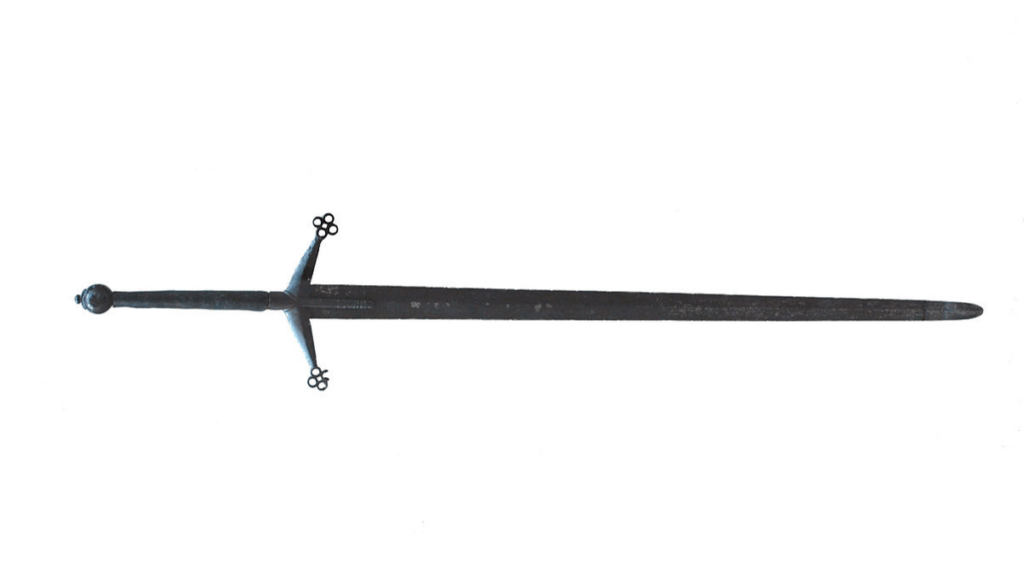If you’ve heard of any of the many anti-personnel mines in the world, chances are that the Claymore mine is top of the list.
Popularized by its many appearances in 80s action flicks, the Claymore is the mine of choice for ripped lone-soldier guerrillas looking to gain an edge on the mercenaries/henchmen/police officers chasing them through the wilderness.
Additionally, its “FRONT TOWARD ENEMY” legend is, well, legendary and immediately recognizable even to the casual anti-personnel-mine enthusiast.
However, even such enthusiasts are unlikely to know every single fact about this iconic weapon – which is where this article comes in.
So check your six, watch your feet, and join us as we reveal all there is to know about the Claymore…
It’s Named After a Scottish Sword
The Claymore mine is not the first of its name. Its inventor – a man named Norman MacLeod – named it for a medieval Scottish greatsword.

In fact, the Gaelic word from which we derive Claymore –claidheamh-mòr – literally means ‘great sword.’
The (Scottish) Claymore is almost as recognizable as its namesake, in fact. Even if you don’t recognize the term, you’ll recognize the sword itself.
It was the sword wielded by Mel Gibson’s Scottish rebel William Wallace in the 1995 epic Braveheart and was featured prominently in the marketing for the movie.
It was also featured in the very last shot of the movie, as Wallace’s compatriots fling it into the earth to signify their defiance against their English oppressors.
It Had Its Roots In The Korean War
When most people think of Claymore mines, chances are they’re thinking – if not of Rambo movies – of the Vietnam War at the very earliest.
While it’s true that the mine didn’t see active use until Vietnam in 1966, it actually had its genesis in an earlier Asian war – the Korean War of 1950-1953, where some of the most famous U.S. Marine quotes were born.
During that conflict, the Americans and South Koreans found that they had trouble dealing with the mass infantry offensives of Chinese soldiers, who overwhelmed their enemies with sheer numbers.
Over the next decade and a half, US military engineers went to the drawing board to devise a weapon that could deal with such mass assaults. The Claymore was the end product of that process.
A Claymore Mine Can Be Detonated In Three Ways
Whenever a Claymore features in an action movie, it’s generally used as an area-denial booby-trap – that is to say, it’s set up with a tripwire, goon #4 walks into the tripwire, and the Claymore is discharged and mulches the hapless goon.
And while that’s one of the ways that a Claymore is activated, it actually has a second mode of operation – remote discharge.
This is exactly what it sounds like – you set the Claymore up, take the paired remote, and activate it when you’re ready.
Finally, the mine’s firing system can be rigged to a timer and set to detonate after a predetermined period of time.
In practice, however, this method (and, ironically, the iconic tripwire method) is seldom used in the field, with the remote detonation option by far the most popular and expedient.
It Began Life As The T-58
The Claymore didn’t spring up overnight; the design and manufacture process was a slow and difficult one for inventor Norman MacLeod, and there was a lot of trial and error involved before landing upon the final design that saw action in the jungles of Vietnam.
McLeod, who owned a company called the Calord Corporation, was asked by the US military to develop an anti-personnel weapon small enough to be carried by infantry yet effective enough to do significant damage to enemy personnel.
The result of this was the T-58 anti-personnel mine. While similar to the later M18A1 Claymore, it lacked many of the features that would make the latter so effective in combat – namely, its effective range and its ease of use.
The T-58 became the M18 Claymore later in its development. Though this was very similar to the M18A1, it had a poor effective range of 27 meters and – crucially – lacked the iconic “FRONT TOWARD ENEMY” legend on the front panel.
The US Army Finished The Claymore Design Themselves
Dissatisfied with MacLeod’s design – and with his later attempt to sue the US Military over the patent for the Claymore – the US Army took things in-house, sourcing the further development of the anti-personnel weapon to Picatinny Arsenal.
Picatinny Arsenal was given very specific requirements for the Claymore. It needed to weigh less than 3.5 pounds (for portability), achieve a 100% strike rate on a man-sized target out to 50 meters, and eject projectiles at a velocity of 1200 meters per second.
Taking the Claymore from its M18 incarnation through to the M18A1 one was no easy task. Work began in 1954; it wasn’t until 1960 that the design was finalized, and it didn’t see field use until 1966.
It’s Hugely Iconic Because Of Its Movie Appearances
More than any other mine, the Claymore is instantly recognizable even to people unfamiliar with anti-personnel weaponry.
The reason for this is simple – the Claymore has been featured in a staggering number of movies.
The primary reason for this is because of the fact that the Claymore is so immediately recognizable.
With its convex shape and the “FRONT TOWARD ENEMY” panel it’s so well-known for, it’s the go-to for directors who want to quickly establish a lethal and effective booby trap – whether directed toward the heroes or the bad guys.
The Claymore featured most famously in a handful of 1980s action movies. The most prominent of these are probably Commando (1985) and Predator (1987), both of which were vehicles for rising action superstar Arnold Schwarzenegger.
The mine was also featured in the melancholy Vietnam War drama Platoon (1986), probably the highest-profile movie about that war to feature the Claymore.
It’s a common misconception that the Claymore is a weapon of choice for Sylvester Stallone’s traumatized Vietnam veteran, John Rambo.
In fact, the mine did not appear in any Rambo movie until 2008’s Rambo, in which the titular character uses it to take out a swathe of Burmese soldiers.
The Claymore is one of the World’s Most Infamous Weapons
The Claymore is, rightfully, one of the most famous weapons in the world due to its iconic design and innumerable movie appearances.
But more than esthetics, it’s a hugely effective anti-personnel weapon. Its simple and elegant design means that it’s still in use to this day – and is likely to be so for many more years to come.

